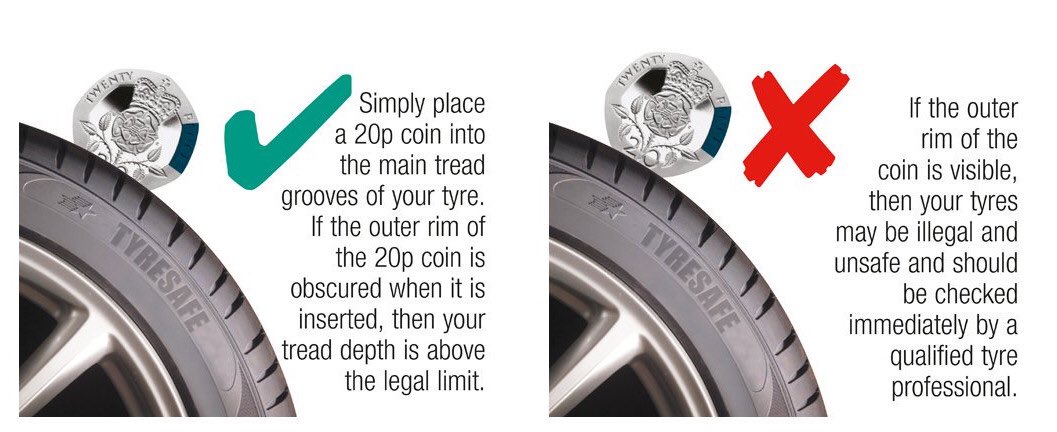« What You Can Expect From the 2020 Nissan Kicks
The 2020 Nissan Rogue Sport Delivers a Bold Design With Matching Performance »
Jun 15, 2020
Do you need new tires? Are you unsure? There is an extremely simple way to check your tire tread depth at home with no special tools! All you need is a quarter and a penny to get started.
Before using the coin, you check your tires for the “wear indicators” as seen in the video above. Look for these rubber notches between the tread of your tires. They are raised to 2/32 of an inch and will tell you when your tires are completely worn to an unsafe level. Once the indicator is flush with the tread, that means it’s time to replace your tires right away.
If your tires do not have these indicators, or if you want to be proactive and get an idea of how much tread you have left before it’s too late, it’s time to use your coins. First, grab your quarter. Insert it in the space between your tire tread, with George Washington’s head facing down. If your tread surpasses the top his head, you are above 4/32 of an inch and are in good shape. Once the tread comes flush with the top of Washington’s head, that means you are at 4/32 of an inch. While still safe, it’s time to start planning ahead. Depending on how much you drive and on what terrain, you’ll need to replace your tires soon.
If you find that your tread is not even touching Washington’s head, you can grab your penny. Insert the penny in the same way, with Lincoln’s head facing down. When your tread is flush with the top of Lincoln’s head that means you are at 2/32 of an inch. As with the wear indicator, this means it’s time to replace your tires. Regardless of season, low tread is unsafe, reducing traction, increasing stopping distance and increasing chances of getting a flat.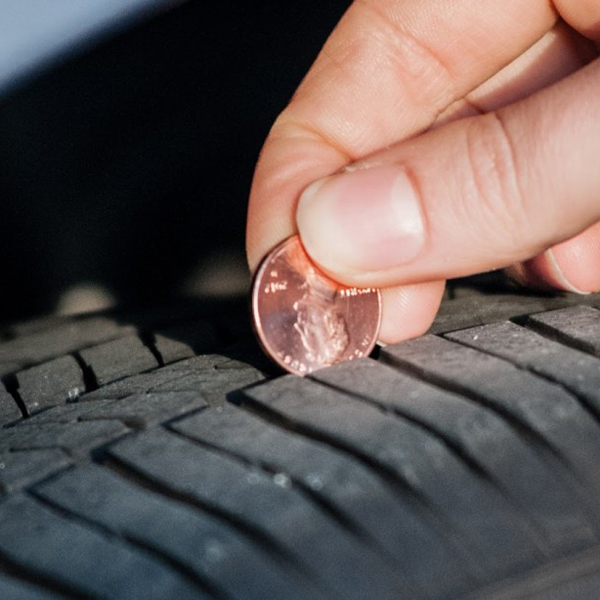
Make sure you check your tread on all four tires and in more than one spot. If you find that the center of your tires is wearing more than the outer edges, your tire is likely over inflated. On the other hand, if the edges are wearing more quickly than the center, your tires are likely under inflated. When certain tires are wear more quickly than others, you might need a tire rotation or alignment. In this case, we’d be happy to help you figure out what needs done to ensure even wear to not only increase the lifespan of your tires, but also keep you driving safely!
If you do need new tires, take advantage of our $70 rebate on a set of four eligible tires though July 31, 2020! Start shopping new tires here.
Tags: Colorado, Longmont, new tires, Nissan, tire tread, tires, tread depth
Posted in
Longmont Nissan Service |
No Comments »
 , Longmont, CO 80501 | Sales: 303-586-2862 | Contact Us | Privacy | Sitemap | NissanUSA.com
, Longmont, CO 80501 | Sales: 303-586-2862 | Contact Us | Privacy | Sitemap | NissanUSA.com
When it comes to checking tire tread, there are a number of methods that can help you know if it’s time to replace a tire. Heavily worn tread will prevent a tire from performing as designed and can lead to unsafe driving conditions. One of the simplest, most common ways to check tread depth requires nothing more than a penny and a few moments of your time.
In the United States, tire tread depth is measured in 32nds of an inch. New tires typically come with 10/32” or 11/32” tread depths, and some truck, SUV and winter tires may have deeper tread depths than other models. The U.S. Department of Transportation recommends replacing tires when they reach 2/32”, and many states legally require tires to be replaced at this depth.
The idea of the penny test is to check whether you’ve hit the 2/32” threshold. Here’s how it works:
Here’s how it works:
Place a penny between the tread ribs on your tire. A “rib” refers to the raised portion of tread that spans the circumference of your tire. Tire tread is composed of several ribs.
Turn the penny so that Lincoln’s head points down into the tread.
See if the top of his head disappears between the ribs. If it does, your tread is still above 2/32” , If you can see his entire head, it may be time to replace the tire because your tread is no longer deep enough.
When performing the penny tire test, remember not only to check each tire, but to check various places around each tire. Pay special attention to areas that look the most worn. Even if parts of your tread are deeper than 2/32”, you should still replace the tire when any areas fail the penny test.
Consistent wear around the whole tire is normal, but uneven tread wear could be a sign of improper inflation, wheel misalignment, or a variety of other things. If you see uneven tread wear, you should have a technician inspect your vehicle.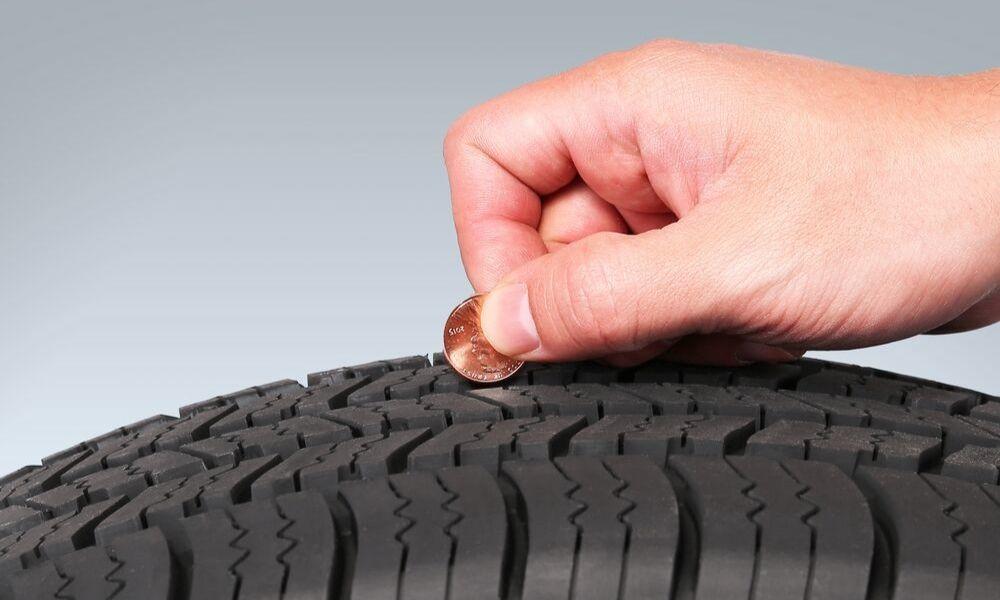
A simple way to check your tire tread depth is by using a tread depth gauge. You can find tire tread depth gauges at your local auto parts store. There are many models available, but an inexpensive simple graduated probe gauge will work just fine. All you have to do is stick the probe into a groove in the tread and press the shoulders of the probe flat against the tread block and read the result. All gauges should measure in both 32nds of an inch and millimeters.
Another indicator of worn out tread already lives in your tires themselves. Every performance, light truck, or medium commercial tire comes equipped with indicator bars (or wear bars) embedded between the tread ribs at 2/32”. They’re there to help you monitor tread depth and make decisions about tire replacement. Just look to see if the tread is flush with the indicator bars. If they are, it’s time to replace the tire.
While the penny tire test does deliver on what it promises – indicating whether tread has reached the legal limit – it may not be the best indicator of whether your tires are safe for the road. Tire performance can diminish significantly before your tread hits 2/32”. Even though the law deems fit for safe driving may not prevent you from hydroplaning or losing control in rainy, slushy conditions. If you think your tires may be close to needing replacement, have them checked out by a licensed mechanic.
In fact, the average life of any tire is 5-7 years, but a lot depends on how the owner treats his car. Aggressive driving, improper seasonal tire storage, unrepaired suspension/balancing problems, incorrect pressure and other errors can significantly shorten tire life. But worn tires can be a serious problem on the road: an increased risk of uncontrolled skidding, hydroplaning, even accidents is the price that drivers and passengers have to pay for using old tires.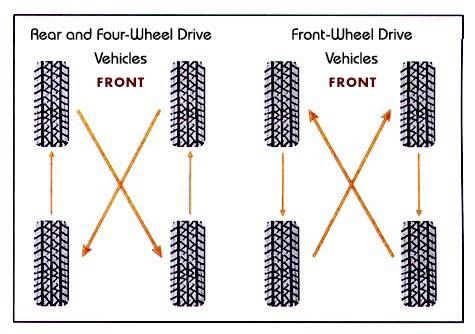
Each manufacturer indicates the so-called wear index on the tire profile, which most often looks like the inscription “Treadwear 100” and means a maximum of 48,000 km on a standard road surface (polygon). In a real environment and often not the most ideal roads, this number actually needs to be divided by 1.5 - we get 36,000 km.
By analogy, if the wear resistance index is 150, then this means “factory” 72 thousand km, 200 - 96 thousand km., and so on.
What are the dangers of worn tires on the road:
adhesion to the roadway deteriorates, which leads to an increased likelihood of skidding, accidents, hydroplaning in case of rainy weather;
reduced cross-country ability in off-road conditions;
increases the risk of a tire puncture while driving.
It is also worth remembering that the issue of tire wear is regulated by traffic rules, and you can get a fine for using “bald” rubber. Knowing what maximum tire wear is acceptable, this is easy to avoid: 1.5-2 mm for summer, and 4-5 mm for winter (a more accurate figure is indicated by the manufacturer).
Knowing what maximum tire wear is acceptable, this is easy to avoid: 1.5-2 mm for summer, and 4-5 mm for winter (a more accurate figure is indicated by the manufacturer).
1. According to the wear indicator on the tire. To find this indicator, you need to inspect the side of the tire and find one of the markings: a triangle, a company logo, a snowflake, or the abbreviation TWI. If the tread has worn down to this indicator, it means that the tire needs to be disposed of urgently.
2. Many people in the old fashioned way prefer to use a 10-kopeck coin. Insert it into the tread with the inscription "10 kopecks" towards you, and if it is visible, the wear level is too high, you need to replace the tire. This method is convenient, but not entirely accurate: by measuring wear in different parts of the tire in this way, it will be difficult to estimate its unevenness by eye, and this is also an extremely important indicator.
3. It is optimal to use a special gauge, depth ruler or caliper for these purposes. This will allow you to measure the wear of the tread in different parts of the tire with an accuracy of up to a millimeter and understand if there is uneven wear.
It is optimal to use a special gauge, depth ruler or caliper for these purposes. This will allow you to measure the wear of the tread in different parts of the tire with an accuracy of up to a millimeter and understand if there is uneven wear.
If measurements show different results in different parts of the tread, it is important to determine exactly how your tires wear in order to understand where and what the operating error is.
If the tread wears more on the sides and the center wears off less, this means that the tire pressure is insufficient and the contact patch with the road is not correct. This leads not only to poor vehicle stability, but also to increased fuel consumption.
If the tread is worn down the middle but the sidewalls are fine, then your tires are overinflated. Sometimes this is done intentionally in order to save fuel, but in this case, the tires will still have to be changed ahead of schedule.
There is also the possibility of increased wear on the inside or outside of the tread - this indicates an incorrect camber. A visual table with wear options and their causes:
Cracks on the sides of tires can indicate frequent off-road driving, improper storage, low-quality rubber or long service life, as well as incorrect tire pressure.
Bulges or "hernias" on the sides of the tires appear as a result of the side part hitting hard obstacles. Tires with such damage are not recommended.
Dents on the tread indicate insufficient depreciation and unadjusted camber. Having found such damage, it is necessary to drive the car to the service and make sure that the suspension is in good condition.
Individual wear spots on the tread indicate aggressive driving / braking, skidding with wheel locks, or prolonged parking of the car in one position.
Most often, this is required for the sale and purchase of used tires in order to orient the buyer in the degree of their wear. Many sellers give this figure at random, but this method has nothing to do with the actual assessment of the degree of tire wear. It is also important to understand that a conditional 50% wear for a summer tire is an acceptable value, while 50% wear of a winter tire tread is a sign that the tire cannot be used. Therefore, it is important to know how to accurately determine the percentage of tire wear so as not to get into an unpleasant situation.
Many people divide the actual tread height by the height of the same, but new tire, and get a certain percentage of wear. This would be correct, if not for one BUT: we cannot physically erase the tread to zero, and the law prohibits the use of tires with a tread below the permitted values.
You can calculate actual tire wear by dividing the difference between the new tire height and the actual tire height by the difference between the new tire tread height and the minimum possible tread height for that tire, and then multiplying this number by 100.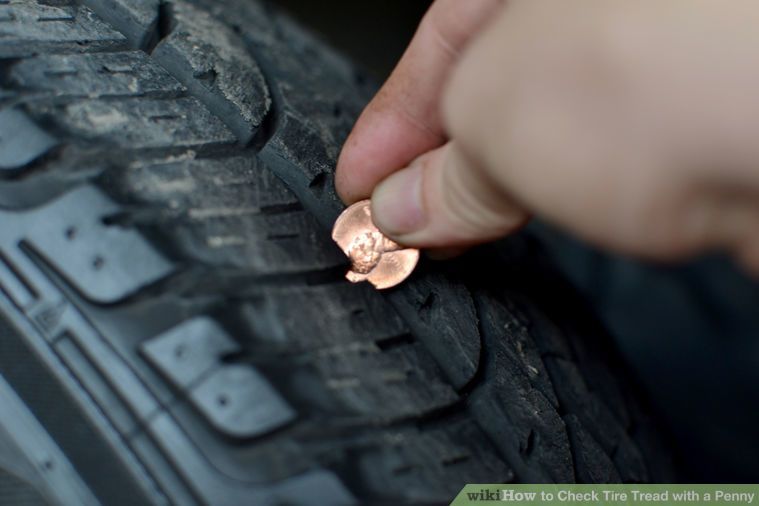
If it is impossible to find out the height of the same, but with a new tire, use the average values of your tire type:
| Tire type | Average tread height at start of use |
| Winter tires with Scandinavian tread | 10 mm |
| Winter with regular or asymmetric tread | 9 mm |
| High-speed winter | 7 mm |
| Summer tires with classic tread | 8 mm |
| Summer speed | 7 mm |
You can check summer tires for wear a little less often than winter tires, since in summer the tread depth is not so important for patency.
If you have assessed the condition of your tires on all of the above factors and realized that the tires are worn out, be sure to replace them with new ones as soon as possible.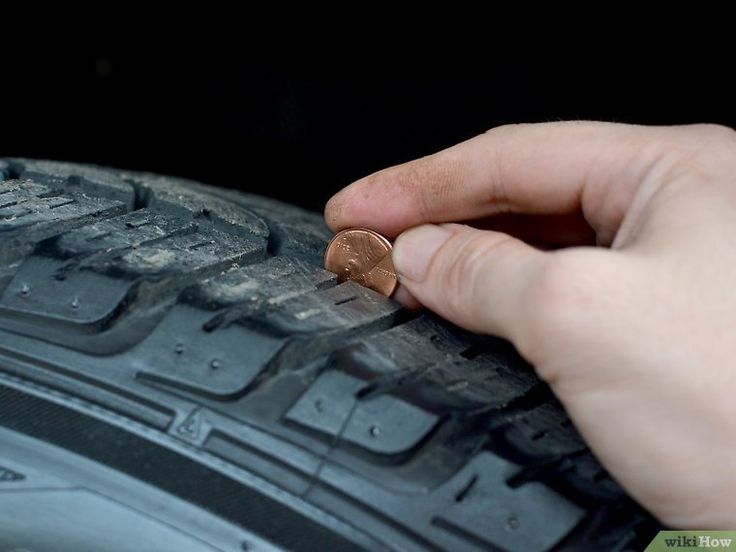
The task of calculating the residual life of a tire can arise both when assessing the condition of one's own wheels, and when buying used rubber. In addition to indirect signs, the residual tread height becomes such a criterion. But it can also be calculated based on subjective assumptions, which is what sellers usually do.
Contents of the article:
here and the unknown with the initial depth of the Age and uncertainty with a maximum allowable residual. The question requires objectivity.
The suitability of tires for further use is determined by their ability to meet safety standards, and is set by the manufacturer using wear indicators or numerical values.
In the absence of such, one should be guided by the requirements of the traffic rules, where the minimum allowable tread depth is set, depending on the type and purpose of tires.
Both do not take into account all the features of wear, therefore, taking care of your own safety, you need to approach the issue as objectively as possible, and not be content with formal criteria.
See also: What is wheel bolt pattern and how to measure it
So, for example, if the tread remains within the allowable millimeters, but the terrain is already severely distorted due to uneven wear, the rubber has lost its properties or the initial height was more than typical, then the tire must be sent to the scrap, although according to numerical indicators it meets the standards.
Most of the assessment methods are available to the average user, although not all of them.
A lot can be assessed visually. For example, the color of rubber loses saturation over time, tires become characteristically whitish. This is a good indication that aging has occurred due to oxidation of the tire material.
Mechanical damage is also visible, both natural in the form of age-related cracks and delamination, and artificial, traces of numerous repairs, cord exposure due to cuts, profile bulges under pressure (bumps).
Related article: Spikes or Velcro, which tires are better to use in winter
Very noticeable uneven tread wear in the form of a saw or bald spots. Such a wheel is dangerous when braking.
To estimate the actual residual value, you need to know the original tread value, as well as the minimum allowable for a particular tire model. A big mistake that sellers most often deliberately make is to consider percentages based on absolute depth.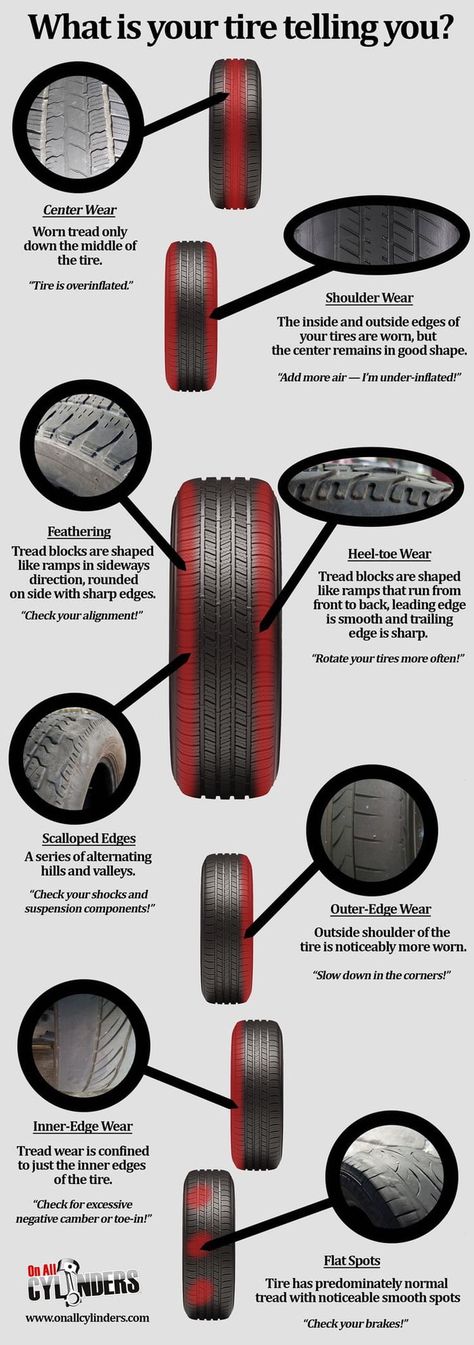
Do not use the tire until it is completely worn out. Moreover, based on the purpose, rubber can completely lose its properties even with a sufficiently deep pattern.
This applies to winter, mud and all season tyres. They must effectively remove the soft component of the road surface from the contact zone, which is possible only with a sufficiently deep tread.
This is the most convenient way to determine tire wear by the manufacturer. In the rubber of the tread, recesses are made in the form of numbers, which disappear as the rubber wears out. The largest of the remaining ones determines the resource height of the relief.
Other indications are also possible, all of them are simple and most intuitive.
Interesting: What and how to glue the molding on the car door
Up to the use by some manufacturers of color indication, when rubber of a different shade is embedded in the depth of the tread.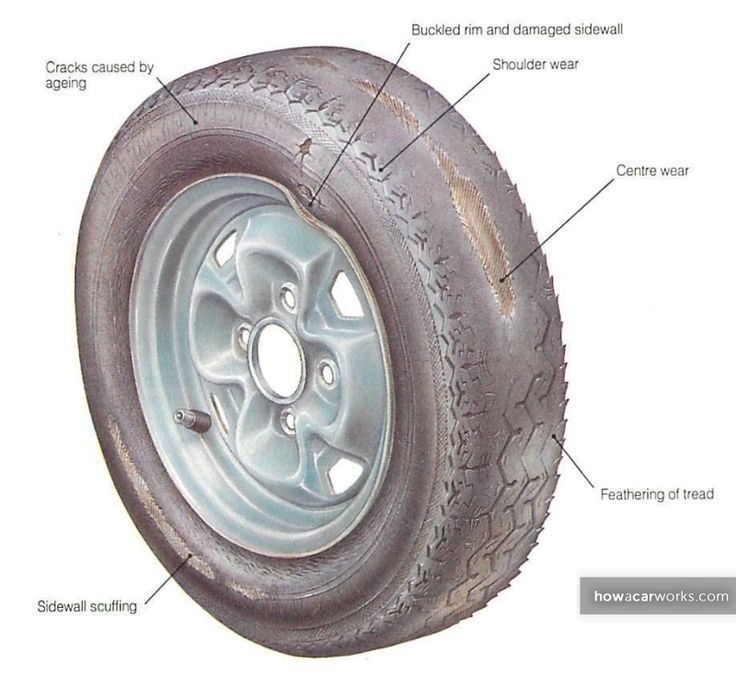 A worn treadmill will then change color to contrast with the rest of the surface.
A worn treadmill will then change color to contrast with the rest of the surface.
Although it is almost impossible to find modern tires without wear indicators at all, the old methods continue to work. Between the checkers or tracks of the tread, you can place a caliper depth gauge, which will show the remaining depth in millimeters.
All that remains is to subtract the minimum allowable value from the resulting number. In the absence of a caliper, you can use a ruler, or even just a coin.
Wheel alignment significantly affects rubber wear, up to complete destruction of the tread for a short run with a strong deviation from the norm.
A distorted toe value results in the formation of a characteristic "saw" on the tracks, which is clearly visible when looking along them. The plane of rotation of the wheel does not coincide with the direction of movement of the car, which is why the tread constantly slips in the contact zone, this causes sawtooth wear.